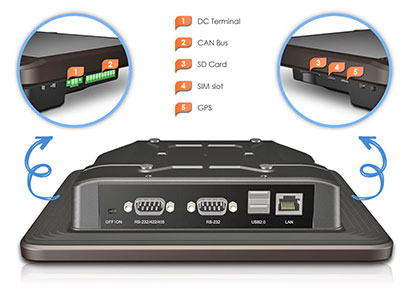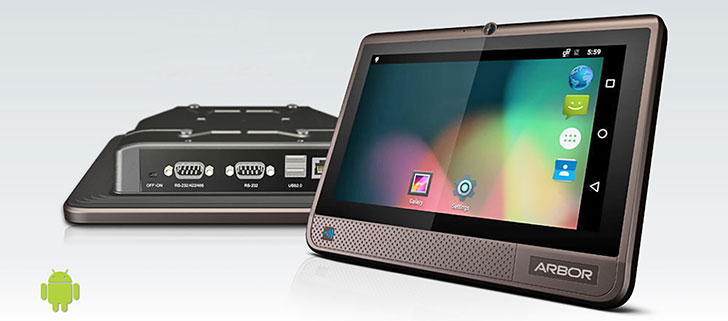ARBOR Technology takes the Internet of Things seriously. For the past couple of years or so, most of the innovative Taipei-based company's new products have been related to IoT applications and projects in one way or another. Which is just good business sense at a time where experts expect 50 billion IoT devices and trillions of Iot-related US dollars in increased revenue and reduced cost within the next ten years.
The 8-inch ARBOR IoT-800 is a follow-up on the smaller IoT-500 5-inch HMI panel, where HMI stands for Human Machine Interface. The IoT-800, though still very compact, offers significantly more screen real estate than is available on the IoT-500's smartphone-sized display. Optimal screen size depends on the application, but both of ARBOR's small IoT panels allow people to interact with the emerging Internet of Things.
This makes these ARBOR panels integral building blocks of the promising vision of a world where internet communication is no longer limited to people communicating with people or machines with machines, but where "things" communicate as well. These things — vehicles, doors, wash machines, fuel injectors, locks, cameras, or entire offices or homes — collect data via sensors, and then pass that data on for information, processing and action.
The ARBOR IoT-800's role is to display data from all sorts of sensors, and, if need be, allow human feedback. Easy as that. And very important.

While Internet of Things terminology is full of acronyms and vaguely defined concepts (like "the cloud"), there's nothing magical about the IoT-800. It measures 8.6 x 6.4 inches — about the size of a big paperback book — and weighs about two pounds. ARBOR calls it a Panel PC, and technically it is, but one that runs Android and has a very tablet-like 8-inch screen with capacitive multi-touch. And just like in any modern small tablet, flush glass extends well beyond the perimeter of the LCD screen, so that fingers can easily operate it without bumping into a bezel frame.
On the backside, though, the IoT-800 does look like a Panel PC much more than like a tablet. There are full-size PC ports and industrial block connectors. The picture below shows what things look like back there.

A downward-facing I/O block features the kind of legacy connectivity that continues to play an important role even in the era of Internet of Things and the Cloud. There's an old-style DB9 RS232 serial port, next to it one that's software switchable to RS232, RS422 and RS485, then a couple of full-size USB 2.0 ports, and finally a RJ45 LAN jack. On the right side are green industrial-looking terminals for power (the IoT-800 doesn't have a battery), and for digital I/O and a CAN Bus and OBD-II interface. Digital I/O lines can be used to interact with all sorts of equipment and sensors. CAN Bus is an electronic bus standard for vehicles, and OBD-II is a standard interface for onboard diagnostics. On the left side are slots for an SD card and a SIM card.
The ARBOR IoT-800 is powered by a non-specified quad-core ARM Cortex-A9 chip. There's 1GB of LPDDR3 RAM, 16GB of onboard eMMC storage, a frontal 2mp camera, GPS, Bluetooth 4.0, 801.11a/b/g/n WiFi, NFC, GPS, and optional mobile Broadband. The display offers 1024 x 600 pixel, which translates into 148 ppi. That's about as much as the original Microsoft Surface tablet, not terribly high, but more than enough for even sophisticated HMI applications (such as complex systems data and sensor readings like shown in the sidebar). And thanks to its projected capacitive touch interface, it allows for easy human monitoring, interaction, response, and control.
The IoT-800 isn't a mobile device in the sense that people carry it around like they would ARBOR's Gladius handhelds and tablets, but it's certainly mobile in vehicles. So ARBOR gave it a very wide 14 to 158 degree Fahrenheit (-10 to 70 degrees Centigrade) operating temperature range. The front panel is IP65-sealed, which means it's totally immune to dust and can also handle low pressure water jets. Drop spec isn't important in a device like this, but we'd like to see vibration resistance data in the specs.
Where can it be used? Almost anywhere. The polymer plastic housing is quite tough. It has a standard VESA 75 x 75 mm screwhole pattern on its back, which means that there's a limitless number of mounting solutions available for it. Since it's designed like a compact panel computer it can also easily be integrated into a dash or panel anywhere.
While ARBOR named this panel computer the IoT-800, there's no need to wait for future or even emerging applications to put it to use. It's equally at home in Point-of-Sale/Service deployments, retail, hospitality, and a myriad of other other projects that require a compact, friendly, versatile panel to interact with all sorts of systems.
ARBOR Technology Corp.
www.arbor-technology.com



